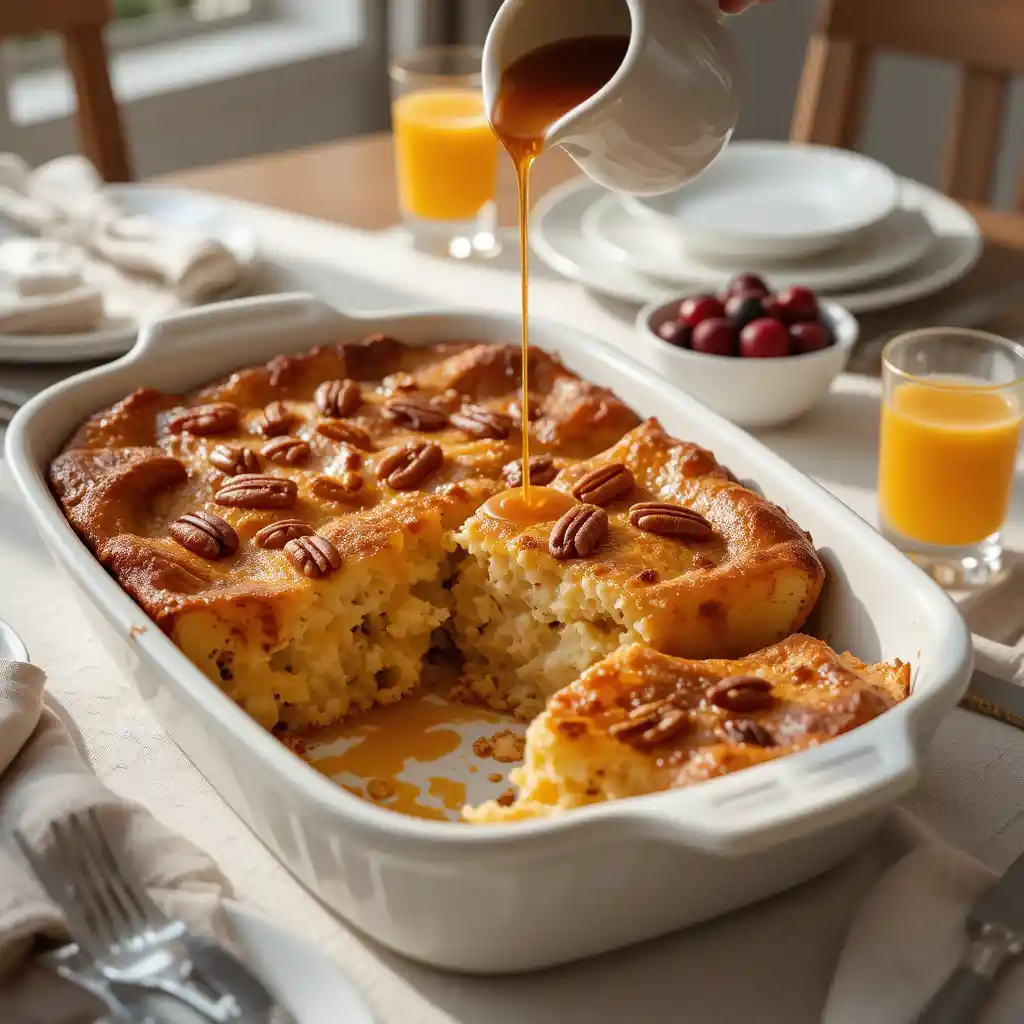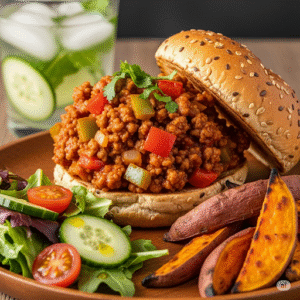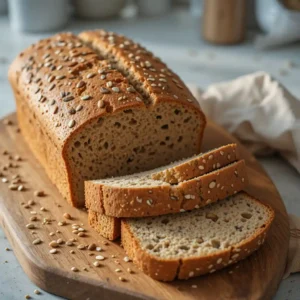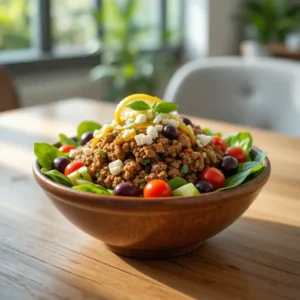Overnight French Toast Casserole: Best 5 Tips From Professional Chefs
Table of Contents
Overnight French Toast Casserole: Best 5 Tips From Professional Chefs
Tired of soggy, underwhelming breakfast casseroles that leave your guests reaching for the cereal box? You’re not alone. The disappointing reality of many French toast casseroles—mushy middles, burnt edges, and flavors that fall flat—has frustrated home cooks for years.
But imagine serving a perfectly balanced Overnight French Toast Casserole with a golden, caramelized crust, custard-like interior, and flavor that rivals your favorite brunch spot. This isn’t just possible—it’s guaranteed when you follow the professional techniques revealed in this guide.
As a culinary instructor who’s trained alongside pastry chefs specializing in breakfast cuisine for over 12 years, I’ve collected the most transformative tips that professional kitchens use but rarely share. These aren’t just minor adjustments—they’re game-changing techniques that will revolutionize your breakfast hosting forever.
In this comprehensive guide, you’ll discover the bread selection secrets, custard ratio formulas, flavor-building techniques, texture enhancements, and foolproof baking methods that separate amateur efforts from restaurant-quality results. Each tip includes detailed explanations, step-by-step instructions, and troubleshooting advice to ensure your success.
Why This Overnight French Toast Casserole Works
- Perfect texture balance: Achieves the ideal combination of crispy edges and custardy center
- Make-ahead convenience: Prep the night before for stress-free morning entertaining
- Flavor complexity: Develops deep, rich flavors through professional layering techniques
- Consistent results: Tested formula ensures the same perfect outcome every time
- Crowd-pleasing appeal: Serves 8-12 people with minimal morning effort
Choosing the Right Bread
Best Breads for Overnight French Toast Casserole
The foundation of exceptional French toast casserole isn’t fancy equipment or rare ingredients—it’s the bread. Professional chefs unanimously agree that bread selection impacts texture, flavor absorption, and structural integrity more than any other element.
For optimal results, prioritize these options:
- Brioche: Rich with butter and eggs, brioche creates luxuriously tender results with built-in flavor
- Challah: The tight crumb structure maintains integrity while soaking up custard beautifully
- Day-old baguette: Offers excellent contrast between crispy edges and soft centers
- Sourdough: Provides complexity and tang that balances the sweet elements
Avoid sandwich bread, which compresses into a gummy layer, and very dense artisan loaves that resist custard absorption.
Bread Prep Techniques
Professional chefs treat bread preparation as a critical step, not an afterthought:
- Proper aging: Allow bread to dry for 1-2 days at room temperature before using
- Uniform cubes: Cut bread into consistent 1-inch cubes for even soaking and baking
- Strategic toasting: For extra insurance against sogginess, lightly toast bread cubes at 250°F for 10 minutes before assembly
Substitution Strategies
Need alternatives? Professional chefs recommend these substitutions:
- Croissants: Create an ultra-buttery result (reduce added butter in the recipe)
- Cinnamon-raisin bread: Adds built-in flavor (reduce cinnamon in your custard mix)
- Gluten-free breads: Choose denser varieties and reduce soaking time by 30%
Ingredients & Prep for Overnight French Toast Casserole

Custard Base Essentials
The perfect custard ratio is Chef Tip #1: Professional kitchens use a precise formula of 1/2 cup milk + 1/2 cup heavy cream + 1 large egg for every 2 cups of bread cubes. This balance creates silky texture without sogginess.
For a standard 9×13 casserole (approximately 8-10 cups bread cubes):
- 2 cups whole milk
- 2 cups heavy cream
- 8 large eggs
- 3/4 cup granulated sugar
- 1 tablespoon vanilla extract
- 1/2 teaspoon salt
Flavor Enhancement Strategy
Chef Tip #2: Layer flavors strategically at three distinct stages:
- Base flavors: Add to custard mixture
- 2 teaspoons cinnamon
- 1/2 teaspoon nutmeg
- Optional: 2 tablespoons bourbon or rum
- Middle layer additions: Scatter between bread layers
- 1/2 cup brown sugar
- 2 teaspoons orange or lemon zest
- Optional: 1/2 cup dried fruit (cranberries, raisins)
- Topping elements: Add during final 15 minutes of baking
- 3 tablespoons melted butter mixed with 3 tablespoons maple syrup
- 1/2 cup chopped nuts (pecans, walnuts)
Preparation Essentials
Chef Tip #3: The soaking method matters significantly:
- Graduated assembly:
- Layer 1/3 of bread cubes in buttered 9×13 baking dish
- Drizzle with 1/3 of custard mixture
- Sprinkle with middle layer additions
- Repeat layering twice more
- Press gently to ensure even soaking
- Rest period: Cover tightly with plastic wrap, then refrigerate 8-12 hours (minimum 4 hours, maximum 24 hours)
Step-by-Step Cooking Instructions for Overnight French Toast Casserole Prep
Pre-Baking Preparation
Chef Tip #4: Temperature management is crucial for texture development:
- Remove from refrigerator: Let casserole stand at room temperature for 30-45 minutes before baking
- Preheat properly: Ensure oven is fully preheated to 350°F
- Apply initial topping: Dot surface with 2 tablespoons cubed butter
- Cover strategically: Tent with foil, ensuring it doesn’t touch the surface
Baking Method
Follow this professional baking progression:
- Initial covered bake: 30 minutes at 350°F (develops internal texture)
- Uncovered bake: Remove foil and continue baking 20-25 minutes
- Final enrichment: During last 15 minutes, brush with butter-maple mixture and add nuts
- Visual doneness check: Surface should be golden brown, and center should register 160°F
Temperature Assessment
Accuracy matters for perfect custard texture:
- Target temperature: 160-165°F in center ensures food safety while maintaining creamy texture
- Testing location: Insert thermometer in center, avoiding contact with bottom of dish
- Visual indicators: Edges should be set but center should still have slight movement when gently shaken
Resting Period of Overnight French Toast Casserole
The often-overlooked final step:
- Rest casserole: Allow to stand 10-15 minutes before serving
- Carry-over cooking: Temperature will rise approximately 5°F during resting
- Texture setting: This period allows custard to set for cleaner slices
Pro Tips for Overnight French Toast Casserole Perfect Results
Avoiding Common Pitfalls
Chef Tip #5: Professional troubleshooting techniques ensure consistent success:
- Preventing soggy centers:
- Use properly dried bread
- Maintain proper bread-to-custard ratio
- Ensure adequate refrigeration time
- Eliminating burnt edges:
- Use a water bath: Place casserole dish inside larger pan with 1″ hot water
- Position rack in middle of oven
- Cover edges with foil if browning too quickly
- Fixing improper texture:
- Too dry: Serve with additional warm maple syrup or fruit compote
- Too wet: Increase uncovered baking time by 5-10 minute increments
Essential Tools
Professional-quality results require proper equipment:
- Ideal baking vessel: Ceramic or glass 9×13 baking dish (conducts heat more gently than metal)
- Mixing equipment: Large bowl and whisk for proper custard emulsion
- Temperature tools: Instant-read thermometer for precise doneness checking
- Storage materials: Plastic wrap and foil for proper overnight storage
Storage & Reheating
Maximize your make-ahead advantage:
- Refrigeration: Baked casserole keeps up to 3 days covered in refrigerator
- Freezing option: Bake, cool completely, portion and freeze up to 2 months
- Reheating method: Individual portions in 325°F oven for 15 minutes; whole casserole covered at 325°F for 25-30 minutes
Flavor Variations
Sweet Enhancements
Transform the base recipe with these professional variations:
- Apple-Cinnamon:
- Add 2 cups sautéed apples between layers
- Increase cinnamon to 1 tablespoon
- Add 1/4 teaspoon cardamom
- Berry Blast:
- Layer 2 cups mixed berries between bread layers
- Add 1 tablespoon lemon zest to custard
- Serve with lemon curd on side
- Bananas Foster:
- Layer caramelized bananas between bread layers
- Add 3 tablespoons dark rum to custard
- Top with rum-spiked caramel sauce
Dietary Adaptations
Customize for special dietary needs:
- Lower Sugar Option:
- Reduce sugar to 1/3 cup
- Use stevia-sweetened maple syrup
- Add extra cinnamon and vanilla for flavor enhancement
- Dairy-Free Version:
- Substitute coconut milk and coconut cream for dairy
- Use coconut oil instead of butter
- Increase vanilla to compensate for flavor difference
- Gluten-Free Adaptation:
- Use gluten-free bread (allow extra soaking time)
- Add 1 tablespoon cornstarch to custard for stability
- Reduce liquid by 1/4 cup
Savory Twist
For brunch with a difference:
- Herb & Cheese:
- Omit sugar and sweet spices
- Add 1 tablespoon each fresh thyme and rosemary
- Layer with 1 cup each grated Gruyère and sautéed mushrooms
- Finish with chives and cracked pepper
Serving Suggestions
Complementary Toppings
Elevate your presentation with these professional finishing touches:
- Traditional options: Warm maple syrup, powdered sugar, whipped cream
- Fruit components: Fresh berries, compotes, caramelized bananas
- Creamy enhancements: Vanilla yogurt, crème fraîche, mascarpone
- Textural additions: Toasted nuts, granola, candied citrus peel
Perfect Pairings
Complete your brunch menu with these complementary offerings:
- Protein balance: Crispy bacon, breakfast sausage, baked ham
- Fresh elements: Citrus salad, berry medley, fruit skewers
- Beverage pairings: Coffee service, mimosas, Bloody Marys, hot chocolate
- Palate cleansers: Yogurt parfaits, smoothie shooters

FAQs
Can I prepare this Overnight French Toast Casserole more than one day ahead? While the optimal soaking period is 8-12 hours, you can prepare the assembled casserole up to 24 hours in advance. Beyond that time, the bread begins to break down excessively, resulting in textural issues.
What’s the best way to serve Overnight French Toast Casserole for a crowd? For gatherings over 12 people, prepare multiple casseroles rather than one oversized version, which may cook unevenly. Keep finished casseroles warm in a 200°F oven for up to 30 minutes before serving.
Can I use frozen bread for my Overnight French Toast Casserole? Yes, but thaw and dry it first. Spread bread cubes on baking sheets at room temperature for several hours or lightly toast at 250°F for 10 minutes to remove excess moisture before assembly.
How do I fix a casserole that’s still too wet after baking? If the center remains too wet after the recommended baking time, remove any toppings that might burn, cover the edges with foil, and continue baking at 325°F in 5-10 minute increments until the center reaches 160°F.
Is this recipe safe for pregnant women? Yes, when baked to the recommended internal temperature of 160°F, this casserole is safe for pregnant women as the eggs are fully cooked. If you’re adding alcohol for flavoring, most will evaporate during baking, but you can omit it entirely for zero alcohol content.
Conclusion
Armed with these five professional chef tips, your Overnight French Toast Casserole will achieve restaurant-quality results that will impress even the most discerning breakfast enthusiasts. The perfect balance of convenience and culinary excellence makes this recipe ideal for special gatherings, holiday mornings, or elevating ordinary weekends.
Start your Overnight French Toast Casserole journey today! The simple act of assembling these ingredients the night before will transform tomorrow’s breakfast experience. Join over 10,000 home cooks who have mastered this technique and discovered the difference professional methods make.
For more breakfast inspiration, explore our related recipes for [Make-Ahead Waffles for Brunch] and [Professional Hollandaise Sauce].







